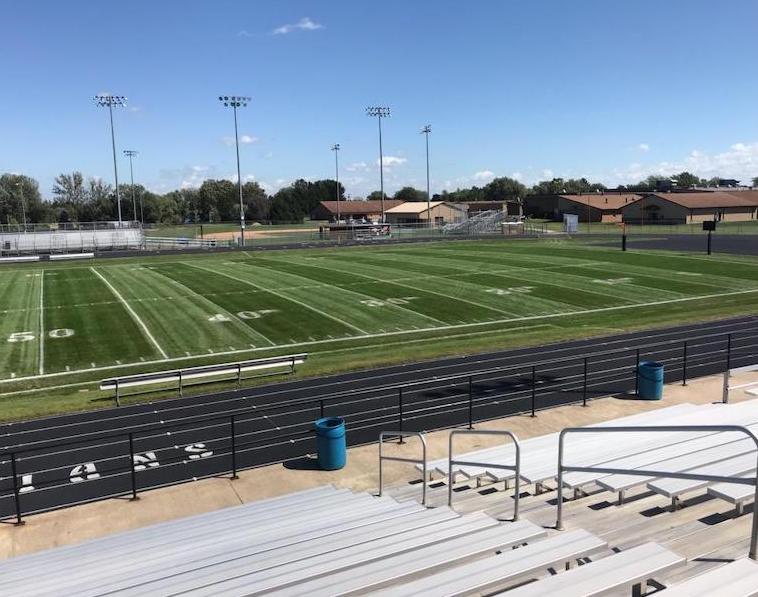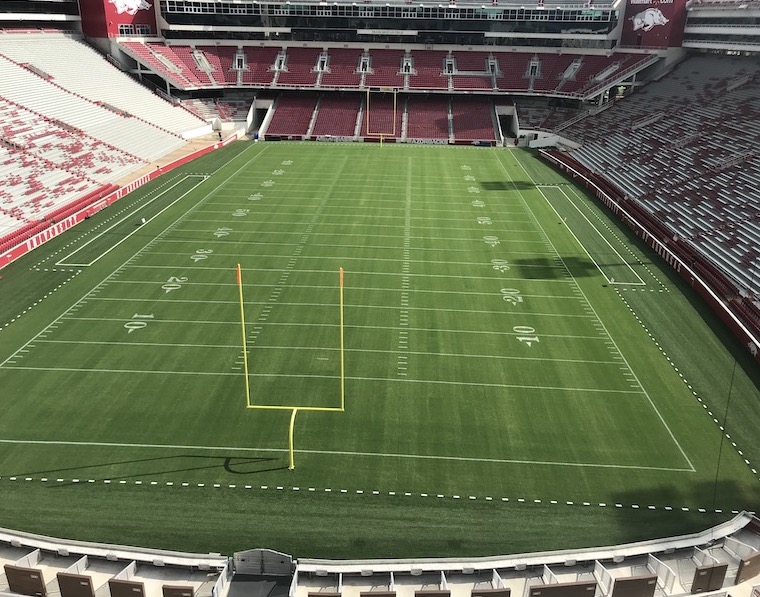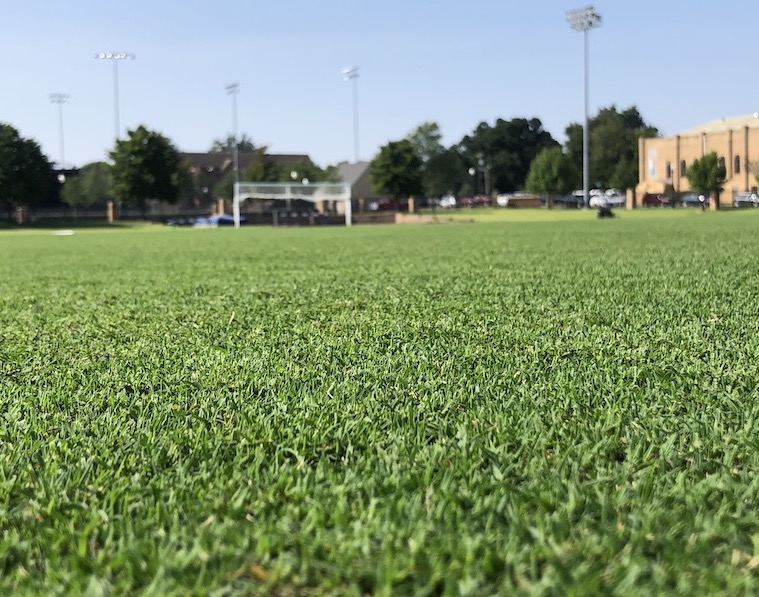For our annual look at turfgrass trends, SportsField Management recently reached out to leading seed and sod companies for their insight. Their responses are presented here in the order in which they were received.
Breeders continue to work on new varieties of tall fescue for use in sports turf. Tall fescues have shown superior wear tolerance, more stable footing, increased disease tolerance and better lateral stability – all of which increase the ability to handle increased traffic and maintain turf cover. Fescues have also exhibited increased recovery and speed of repair due to high tillering and rhizomes in certain varieties. They are tolerant of lower mowing heights, have increased disease resistance, and drought tolerance – all of which offer more flexibility in the use of tall fescue
At DLF Pickseed, we are proud to introduce a new brand specifically geared to the sports turf and turfgrass producers industries – Competition Grade. Competition Grade blends and mixtures use varieties that are chosen for attributes that will aid in quick self-repair, fast establishment, early spring green up, high wear tolerance and increased shear strength, active cool-weather growth, and reduce major diseases. There are three series focusing on the three major species of perennial ryegrass, tall fescue, and Kentucky bluegrass.
When it comes to seeding athletic fields, sports field managers should always use quality seed from trusted sources with varieties that have been tested by NTEP or local universities in their area for maximum performance. Seeding often – prior to and after games – is an excellent way to achieve seed-to-soil contact without interrupting play. This is important in high-traffic areas, such as goalmouths, hash mark areas and player positions, and it will increase your seed bank to assure you have new seed coming in throughout the season.
– Matt Duncan, CSFM, pro turf account manager, DLF Pickseed

Athletic field management trends have continued to change for the better. One growing trend is the use of improved tall fescue varieties.
Managers have historically relied on Kentucky bluegrass for great-performing sports fields. Recently, tall fescues have been developed that combine excellent playability with spreading technology for faster recovery. La Crosse Seed offers mixes with tall fescues that exhibit rapid tillering and rhizome activity. Earth Carpet Tuff Stuff is an example of a mix with the best of both worlds – tall fescue and bluegrass.
Another major trend is the increased demand for turfgrass mixes that have improved playability and are more sustainable in diverse environments. To meet this need, La Crosse Seed has upgraded several of its Earth Carpet turf mixes with A-List-approved varieties.
A-List (Alliance for Low Input Sustainable Turf)-approved turfgrass varieties can help athletic field managers reduce input costs, as well as expensive management and labor costs. These seed products are proven to require fewer inputs while maintaining the same, or better, turf quality. Metrics evaluated include water usage, fertilizer needs, and heat and drought stress tolerance – all without the use of fungicides or insecticides.
– Jeff Wienkes, La Crosse Seed regional sales manager, turf lead

I see more and more new sports field projects being installed as natural grass as opposed to synthetic turf. I am personally seeing a lot of sports field complexes that are putting natural grass down. Many of them are municipal fields in the eastern United States. I think it’s following homebuilding where the subdivisions are being built and there’s a need for new sports fields. They’re building these large sports field complexes where there are multiple-use facilities that have baseball, softball, soccer and football. In the past, they would either have been synthetic or possibly cool-season turfgrass, but now they’re being done in bermudagrass.
There is a rising trend to replace synthetic fields with natural grass. When a high-profile institution like the University of Arkansas, for example, changes out its synthetic turf football field to go back to natural grass (in this case, Tahoma 31 bermudagrass), it’s indicative of what is going on all over the country. I think it’s because of the multiple sports injuries that can be inflicted by a synthetic field. We just saw a backlash from the NFL Players Association in September when they demanded that the NFL swap all of its synthetic fields back to natural grass. These are devastating injuries that could end a player’s career. It’s no wonder we are seeing a natural grass resurgence.
The change from synthetic turf to natural grass is happening in soccer, too. When the USA vs. Mexico International Friendly tournament was played in September of 2019 at MetLife Stadium in East Rutherford, N.J., (home of the N.Y. Giants), the league insisted the stadium cover the artificial turf with natural grass. Tuckahoe Turf sod farm installed Tahoma 31 bermudagrass on top of the synthetic turf, the teams played the game, and then Tuckahoe Turf rolled up the sod and removed it the day after the game. They took the sod back to the farm and planted it in the field again.
A big trend we are seeing is that new fields and renovations are leaning toward installing warm-season grasses in historically cool-season grass areas. Where you’d traditionally see bluegrass or fescue, one of the warm-season grasses that we are really seeing a lot of success with in what I would call cool-season locations, is Tahoma 31. They’re installing Tahoma 31 on those fields, whereas historically it might have been bluegrass.
The change to warm-season grasses in what had been solidly cool-season regions is happening everywhere. It’s happening in Ohio. It’s happening in Indiana. I see it in those areas, mostly on soccer fields and high school football fields at this time. It’s happening internationally as well. It’s happening in Japan where they’re taking out cool-season grass sports fields in northern Japan and putting in Tahoma 31. So it’s not just the Mid-Atlantic or Midwest, It seems to be almost a worldwide trend.
The Philadelphia Eagles NFL team have generally planted bermudagrass for the warmer preseason then replaced it with a cool-season grass in the fall. This year, so far, the Eagles planted Tahoma 31 bermudagrass, and rather than rip it out, they overseeded it. It appears that they’re planning on playing on it throughout the season – a warm-season grass in Philadelphia!
When you consider why sports field managers are switching from cool-season grasses to warm-season grasses, I think it has to do with the wear tolerance of the warm-season grasses versus the cool-season grasses, especially in soccer. It also probably has a lot to do with the height of cut, because you can mow these warm-season grasses down a lot lower and get a much faster, firmer field than you can with your traditional cool-season bluegrasses and fescues. And then there’s also water concerns, disease concerns and how warm-season grass tolerates summer weather a lot better.
Tahoma 31 seems to be one of the better varieties that people are using farther north into the upper transition zone and even historically cool-season areas, because of its cold tolerance and its wear tolerance. So it seems to be on the forefront of varieties that people would be choosing from – Tahoma 31, Northbridge and Latitude 36.
– Chad Adcock, VP of business development, Sod Production Services (licensor of Tahoma 31)
What an incredibly difficult year for sports field managers. Some fields are perfect from a lack of play, and yet others have received an excessive amount of usage due to traditional sports and indoor activities being moved outside. So, what’s in store for 2021?
Many fall sports are being moved to early spring. In fact, athletic directors are looking at late February/early March for starting these fall sports. However, if you are in the cool-season region, some of you are going to be plowing snow to get on your fields. Others are just going to have a great deal more play on dormant turfgrass. In addition, traditional spring sports are going to be right on the heels of this early season. Therefore, we can expect excessive amount of play on fields this spring, and the window between spring sports and fall sports is going to be even shorter.
So, what trends will we see?
Dormant seeding, even in December without snow cover, will be a huge asset. Timing is ideal, and this seeding period might be even more critical this year. If seeding tall fescue, consider higher rates then normal; and if it’s Kentucky bluegrass, consider coated seed to protect from rodents and stay with traditional rates.
If your only window for seeding is next spring in the cool-season region, the “roulette option” for seeding might be the best option. Instead of putting all your seed down at one time, consider seeding more often at lighter rates.
With spring damage and a short timeframe between seasons, sod might make the most sense for repair in the spring. However, sod availability in the early spring is not always possible, and budgets maybe extremely tight this year.
If you’re using Kentucky bluegrass, there are a lot of options. Bluegrasses are not the same, and there are a group of them that do much better on sports fields. Some varieties establish quicker, and others have a better wear and traffic tolerance. If cost is going to be a concern, do not always look for the cheapest option. Consider variety performance, seed quality, poa free and seed count. Some bluegrasses have almost twice the amount of seed per pound as common types, and this can be an option of reducing your seeding rate.
In the transition zone, Bluemuda is getting more and more attention. It will be interesting to see next spring if there is more Kentucky bluegrass or bermuda in each stand. HGT, 365 and HD Sports Bluegrass blends have done very well in the various selections of bermudagrasses. Bluemuda has shown promising performance, but another year of experience will provide better guidance on how far north, and how far south they can work.
It looks like the perennial ryegrass crop was off in Minnesota and Canadian production areas in 2020, so the market is short. I’m seeing some bluegrass/ryegrass formulations that are containing tetraploid perennial ryegrasses, along with traditional perennial ryegrasses (diploids). Tetraploids are normally used as forage ryegrasses. They traditionally do not have the performance of diploids, but it will be interesting to see how they perform.
– Wayne Horman, turfgrass agronomist/consultant, Landmark Turf & Native Seed
A current trend we are seeing in the sport turf market is spreading perennial ryegrasses. Natural Knit blend is well suited for use on athletic fields, because it produces a very fine, tight sod with up to double the turf density and durability. Its aggressive spreading habit helps turf fill in fast for quick recovery. Natural Knit’s strong spreading characteristics helps crowd out and control weeds. Natural Knit varieties Saguaro, Allante and Savant can be used in any region that currently uses perennial ryegrasses for permanent turf applications.
Many areas have been experiencing drought conditions. Because of this, we have seen increased interest in drought-tolerant turfgrass. Using drought-tolerant turfgrass varieties allows turf managers to conserve water while still getting the many environmental benefits a healthy turf provides. Columbia Seeds varieties –Thunderstruck tall fescue, Trinity tall fescue and Savant perennial ryegrass – have all exhibited excellent drought performance in the NTEP or other university trials.
Salt problems are of great concern in the arid and semiarid regions where salt content of soils is naturally high, and precipitation is not enough to leach out the soluble salts. Problems associated with saline soils and saline irrigation water may increase in the future as more marginal quality waters are applied to turf sites. One of the most efficient ways to improve the health of the turfgrass in salinity stress situations is to select and use salt-tolerant cultivars. Columbia Seeds ST perennial ryegrass blend is comprised using highly rated salt-tolerant varieties that could include Savant, Pepper II, Pillar II or Principal II.
– Columbia Seeds

We’re seeing a commitment to some recent concepts in the sports turf industry. One of those is the ongoing use of fraise mowing for sports fields. Whether being used to remove Poa annua and rejuvenate a sports field with a traffic-tolerant product like Turf Blue HGT, removing excessive thatch accumulation, or simply transitioning to a whole other turfgrass species, fraise mowing looks to be a long-term cultural practice tool. This is being combined with the understanding of “you get what you pay for.” Managers are turning to higher-quality seeds and seeding equipment to most effectively get them established.
The Bluemuda concept continues to spread through the transition zone among sports fields and golf courses alike. The concept has been around about a decade, but we’re still researching and learning more as time progresses. Initially, the concept was used to improve high-use bluegrass fields’ recovery in the summer by overseeding with seeded bermudagrass varieties, then seeding bluegrass back into the stand in the fall. More recently, the industry has been pushing the Bluemuda concept into combining the best genetics on both the bluegrass and bermudagrass side.
While discussing the topic with Jerad Minnick of the Natural Grass Advisory Group, he said, “These newer varieties are incredible. Bermuda grows so fast and so strong. Bluegrass takes heat so well and fights off disease amazingly. We are truly in a time period that grass varieties are creating entirely new possibilities for high-use grass because of how they grow.” Minnick and others in the industry are seeing elevated potential in high-use sports fields using the latest genetics in bluegrass and bermudagrass, however, not entirely in the Bluemuda concept. These new genetics are so advanced in aggressiveness and disease resistance that, when combined, they might be increasing competition and decreasing peak performance. Bluemuda certainly has a place in the industry, and we’ll continue to learn more of the pros and cons over time. For managers looking for maximum potential out of a high-use sports field, varietal predictability and taking advantage of recent genetic gains may outweigh the need to test and implement Bluemuda.
Another trend that is likely of no surprise is the push to maintain grasses at a lower and lower mowing height. We see this being done more frequently within tall fescue, with some looking to take the grass well below 1 inch. The desire here is to create a high-quality field while retaining attributes known to the species such as drought tolerance and low nutrient requirements. Taking some of these grasses to lower heights can be done, but comes with its own set of challenges. While drought tolerance capacity will be reduced at lower mowing heights, you can still expect performance advantages compared to other less drought-tolerant species such as perennial ryegrass. Growing at these heights will obviously require more applications at smaller amounts to match the growth rate, but will likely require more nitrogen (N) and other nutrients than typically required of the species at taller heights of cut. As another forewarning, tall fescue tends to be high in clipping yield compared to Kentucky bluegrass and perennial ryegrass, resulting in the need to stay on top of regular mowing events. Turfgrass breeding is pushing to increase turfgrass density within tall fescue, which will help with competition at low mowing heights against grassy weeds such as Poa annua, so newer genetic gains can see higher turf quality and performance at lower mowing heights.
Time will tell of the complete impact COVID-19 has had on the seed industry, but the indication is that it has increased seed demands in some of the turfgrass industries. Seed retail markets have seen high demand with many homeowners in the United States quarantined at home, spending time and money on home improvement. Golf and sports turf haven’t seen the same scale of demand as retail, but have slowly grown as much of the country slowly opened back up in summer and fall. Golf has seen large amounts of rounds being played, as it is one of the few accepted socially distanced activities in even the hardest hit areas of the country. Sports turf isn’t quite back to full capacity, and is unknown how long it may last. Early on in spring of 2020 we saw many projects in sports turf with little play, allowing some to get to much needed turf care. This uptick in projects seemed to gradually reduce throughout 2020 as the year winds down and more uncertainty approaches.
High demand in the seed industry has led to some slight increases in prices. The industry is tight on perennial ryegrass, but longer in tall fescue. Supply and demand for ryegrass and fescue is very cyclical in nature, and is tied to the Oregon Grass Seed Bargaining Association (OGSBA). Just a few years ago, tall fescue was in high demand and low supply just as we’re seeing in perennial ryegrass today. The bargaining of prices from seed growers and seed companies is cyclical, but has stabilized pricing in general, becoming somewhat predictable based on seed inventories. In the end, the best practice as a sports field manager is to plan known projects and seek seed needs well in advance. With turfgrass performance at the forefront of the sports industry, settling for substandard genetic quality due to low inventory can be frustrating. During these times of high demand, don’t be afraid to reach out to your local distributors or even seed companies directly to see if they can be of assistance.
– Micah Gould, market development manager, professional divisions, Barenbrug


